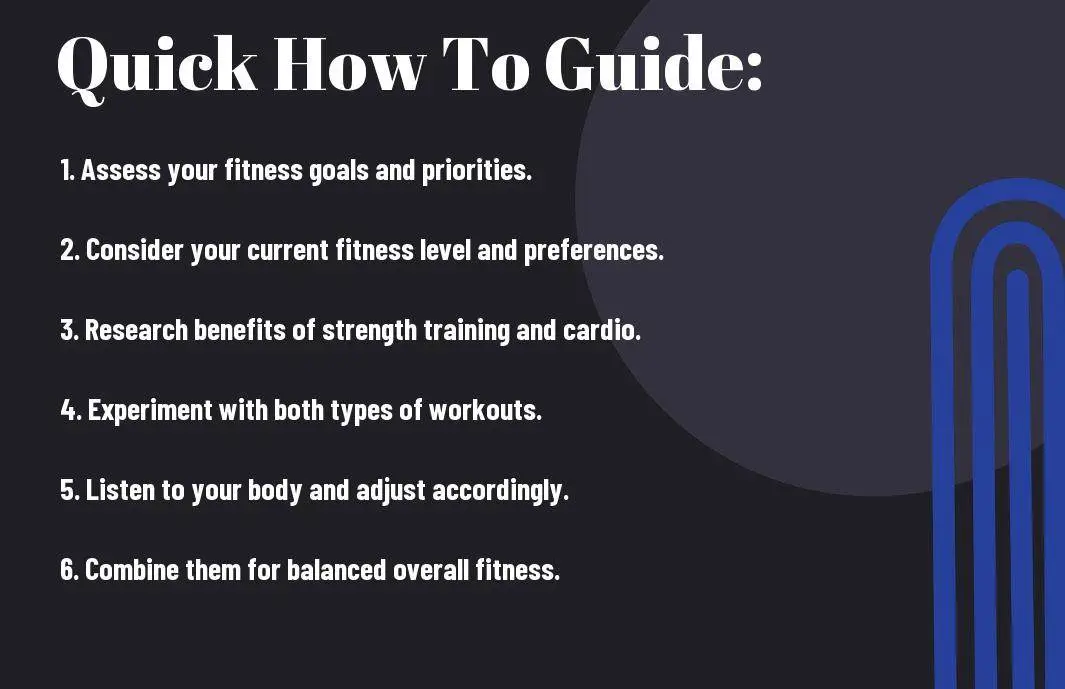Strength training vs cardio which is best for you
Most people find themselves deciding between strength training and cardio when creating their fitness routines. Each has its unique benefits, and what works best for you depends on your individual goals, fitness level, and preferences. This guide will provide you with valuable insights to help you determine which approach aligns best with your health aspirations, whether you’re aiming for weight loss, muscle gain, or overall wellness.
Understanding Strength Training
While many associate fitness with cardio exercises, strength training plays a vital role in achieving overall health and wellness. This form of exercise focuses on using resistance to build muscle, enhance endurance, and improve functional strength. By incorporating strength training into your routine, you can develop a balanced fitness regimen that supports your long-term physical goals.
What is Strength Training?
With strength training, you engage in specific exercises that utilize various forms of resistance, such as weights, resistance bands, or even body weight, to challenge your muscles. This practice is not just limited to traditional weightlifting; it can also include movements like push-ups, squats, and resistance machine workouts. The primary objective is to increase your muscle strength and endurance.
Benefits of Strength Training
The benefits of strength training extend beyond just building muscle. It enhances bone density, improves metabolism, and promotes better posture and balance. This type of training also plays a significant role in boosting your overall confidence and mental well-being.
Benefits increase as you consistently participate in strength training. You may notice a decrease in body fat, improvements in athletic performance, and increased functional mobility in daily activities. Additionally, it can help manage chronic conditions such as arthritis and diabetes, making it a versatile and vital aspect of your fitness journey.
Understanding Cardio
Even if you’re focused on strength training, cardio workouts play an vital role in your overall fitness. Engaging in cardiovascular exercises can improve your heart health, increase stamina, and elevate your mood. Whether it’s jogging, cycling, or dancing, incorporating cardio into your routine can enhance your performance in other activities and contribute to a balanced fitness plan.
What is Cardio?
What you may not realize is that cardio, or aerobic exercise, refers to any activity that raises your heart rate and helps improve your body’s oxygen consumption. This includes exercises such as running, swimming, and group fitness classes that elevate your cardiovascular system’s efficiency.
Benefits of Cardio
Cardio training offers numerous benefits that can significantly impact your health and fitness journey. It helps burn calories, which can aid weight loss or maintenance, while also strengthening your heart and lungs, improving your endurance, and boosting your mood through the release of endorphins.
Benefits of incorporating cardio into your routine extend beyond just physical fitness. You’ll find that consistent aerobic exercise can lead to improved mental clarity, reduced stress, and better sleep quality. Additionally, as you become more physically active, you may notice enhanced resilience and reduced risk of chronic diseases, setting a solid foundation for your overall well-being.
How to Determine Your Fitness Goals
Some people may focus on weight loss, while others prioritize building muscle or enhancing endurance. To determine which path is best for you, reflect on your personal aspirations and consider how much time you can commit to training. Understanding your fitness journey begins with clearly defining your goals, whether that’s improving overall health, competing in sports, or simply leading a more active lifestyle.
Assessing Your Objectives
Fitness goals should be specific and measurable to help guide your training choices. Think about what you wish to achieve in the short and long term. This clarity will enable you to tailor a balanced routine that incorporates both strength training and cardio to support your overall objectives.
Identifying Your Physical Limitations
You may encounter physical limitations that affect your ability to engage in certain activities or exercises. It’s crucial to recognize these limitations to develop a safe and effective fitness plan tailored to your capabilities.
Identifying your physical limitations starts with self-assessment. Consider factors such as previous injuries, any chronic conditions, and your current fitness level. It may also be beneficial to consult with a healthcare professional or a fitness expert who can provide insights into what activities are suitable for you. By understanding your limitations, you can choose appropriate strength training and cardio exercises that challenge you without risking injury, ultimately aligning your fitness regimen with your goals.
Tips for Incorporating Both Training Types
All fitness enthusiasts can benefit from a balanced approach that combines strength training and cardio. Here are some tips to help you integrate both into your routine:
- Set clear fitness goals.
- Schedule specific days for strength and cardio workouts.
- Start with shorter sessions and gradually increase intensity.
- Incorporate both types in the same session, alternating exercises.
- Listen to your body and adjust as needed.
After creating a routine, focus on maintaining consistency to see the best results.
| Strength Training | Cardio |
|---|---|
| Increases muscle mass | Improves cardiovascular endurance |
| Enhances metabolism | Aids in fat loss |
| Supports bone health | Boosts lung capacity |
| Improves strength and power | Elevates mood and reduces stress |
| Needs recovery time | Can be done daily with low impact |
Balancing Strength and Cardio
On your fitness journey, achieving the right balance between strength and cardio is important. Aim to include both types in your weekly routine to optimize overall health and fitness. For example, alternate strength training days with cardio sessions, ensuring you’re giving your muscles time to recover while still maintaining cardiovascular fitness.
Creating a Weekly Workout Plan
If you want to create an effective weekly workout plan, outline your sessions in advance. Consider your personal schedule, and ensure you allocate time for both strength and cardio workouts to maximize benefits.
Weekly planning can set the foundation for your success. For instance, plan three strength training days and two to three cardio sessions each week. Be flexible; switch days around if necessary, and include rest days to allow your body to recover. This approach helps you maintain a balanced program while keeping things fresh and engaging.
Factors to Consider When Choosing Training
Unlike cardio or strength training, the best option for you depends on several personal factors. Consider the following:
- Your fitness goals
- Your current health status
- Your preferences and enjoyment
- Your available time for workouts
Assume that understanding these factors can significantly enhance your fitness journey.
Age and Fitness Level
Even at different stages of life, your age and fitness level can significantly influence your choice. Older adults may benefit more from strength training to preserve muscle mass, while younger individuals might enjoy high-intensity cardio. Tailoring your routine based on your current health and experience will yield better results.
Lifestyle and Availability
Factors like your daily schedule and personal commitments heavily affect your training choice. The more time you can dedicate to workouts, the more variety you can introduce into your routine.
Understanding your lifestyle is key to maintaining a consistent exercise regimen. If your schedule is packed, shorter, high-intensity workouts may suit you better than lengthy sessions of strength training or cardio. Alternatively, if you have flexibility, you might prefer combining both types of workouts to diversify your fitness plan and keep you engaged.
Making Informed Decisions
After weighing the benefits of strength training and cardio, it’s crucial to make informed decisions based on your personal goals, preferences, and lifestyle. Understanding the unique advantages each form of exercise offers can help you create a balanced regimen tailored to your needs. Assess your current fitness level, consider potential injuries, and reflect on what you enjoy the most to ensure consistency and motivation in your fitness journey.
Listening to Your Body
Assuming you are in tune with your body’s signals is vital for optimizing your fitness routine. Pay attention to how you feel during and after workouts; fatigue, soreness, and even enthusiasm can guide your decisions. It’s important to adjust your training regimen based on your energy levels and recovery rates, allowing for adequate rest and proactive changes to improve your overall performance and avoid burnout.
Consulting with Fitness Professionals
Professionals in the fitness industry can provide valuable insights tailored to your personal goals and circumstances. Their expertise allows you to navigate the numerous options available, whether you pursue strength training, cardio, or a balanced approach. Engaging with trainers or coaches can also ensure you are utilizing proper techniques, maximizing effectiveness, and adhering to a regimen that aligns well with your long-term aspirations.
With the guidance of fitness professionals, you can receive personalized advice that takes into account your fitness level, health conditions, and specific goals. They can help create a balanced workout plan that incorporates both strength training and cardio, ensuring you achieve a well-rounded fitness routine. If you encounter obstacles or need motivation, having a professional to turn to can keep you accountable and committed to your journey toward better health.

Summing up
To wrap up, the choice between strength training and cardio ultimately depends on your personal fitness goals and preferences. If you’re looking to build muscle and increase strength, strength training may be more effective for you. Conversely, if your aim is to improve cardiovascular health and endurance, prioritize cardio workouts. Consider incorporating both modalities into your routine for a balanced approach that can maximize health benefits, enhance fat loss, and improve overall physical performance. Listen to your body and choose what aligns best with your fitness journey.
